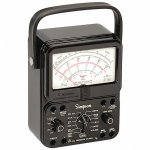Jpflex
Electrician big leagues
- Location
- Victorville
- Occupation
- Electrician commercial and residential
has anyone ever encountered voltage although small 15 VAC showing up at switch leg from switch and with switch in off position?
Source is 120 VAC line power goes to lower switch screw as typical and switch leg is at second top screw (for typical two screw single pole switch)” “Tick tracer” beeped voltage at center pin of lamp holder inside of neutral threaded portion of lamp holder when switch was in off position.
Neutral from lamp holder has 0.5 ohms continuity to breaker panel bus and there is no partial closing of switch contacts in off position of switch, as switch contacts are OL when in closed position.
There was no bulb in lamp holder and no continuity between line and neutral pins of lamp holder
Not sure why 15VAC is showing up on switch leg between switch and lamp power or switch line leg terminal (center point of lamp holder?).
Circuit performs normal with heat lamp bulb in. Switch on turns in on and off turns it off?
Source is 120 VAC line power goes to lower switch screw as typical and switch leg is at second top screw (for typical two screw single pole switch)” “Tick tracer” beeped voltage at center pin of lamp holder inside of neutral threaded portion of lamp holder when switch was in off position.
Neutral from lamp holder has 0.5 ohms continuity to breaker panel bus and there is no partial closing of switch contacts in off position of switch, as switch contacts are OL when in closed position.
There was no bulb in lamp holder and no continuity between line and neutral pins of lamp holder
Not sure why 15VAC is showing up on switch leg between switch and lamp power or switch line leg terminal (center point of lamp holder?).
Circuit performs normal with heat lamp bulb in. Switch on turns in on and off turns it off?



